Conferences Under Trees....
"...Years ago I heard somebody say that all our political and diplomatic conferences ought to be moved out of smoke-filled rooms and held underneath trees...
I wonder if under those circumstances the conclusions reached might not be quite different from what they are at present..."
( page 159 of “The Lost Myth,” by Clyde S. Kilby. Arts in Society, Vol. 6, 1969.) For a brief biography of Clyde S. Kilby, click here. This information is from a wonderful blog, the Saunterer.
from justfocus in New Zealand
Imagine if the United Nations met under trees?
Trees are a wonderful mediating influence in our lives and are there to help.
I believe the UN discussions might be a little more fruitful if held under the canopy of a stately sugar maple.
This goes for children too:
If a child misbehaves, instead of sending them into a corner, have them go outside and sit at the base of a tree...or better yet - up in its limbs! Tell him or her to talk to the tree and listen to its guidance.
 |
| source: Telegraph UK, a great article |
The children would know exactly what you mean (up until about age 9). No tree out there? Ah! now is to the time to plant one!
In my book, 'Heaven is a Garden' I have a chapter named, 'Calling on the Trees'. I write about the power a tree can have on our wellbeing.
We should honor trees for their quiet but powerful influence in our lives. Here are few below that are noteworthy.
Great Elm of Pennsylvania (actually, Great Elm Tree of Shackamaxon)
In 1682, along the banks of the Delaware River, under the shade of a great elm tree, William Penn made a Treaty of Friendship with the Native Americans which led to the founding of Pennsylvania.
William Penn's Treaty with the Indians became a universal symbol of religious and civil liberties.
Voltaire made reference to the event in 1764 and artists throughout Europe recreated the scene. Edward Hicks (artist of the famed Peaceable Kingdom) painted numerous depictions of the treaty meeting to promote social change.
The "Great Elm", as it was known, remained a living reminder of this event until it fell during a violent storm in 1810. You can still visit Penn Treaty Park.
 |
| Great-Grandson of the Great Elm Tree at Haverford College |
The Treaty Oak (Quercus virginiana)
Treaty Oak in 1970's from Mr G's photos in Picasa
Tejas, Apache and Comanche tribes revered these trees. It was here that Stephen F. Austin closed the first boundary line pact with the Indians.
The Austin "treaty oak" is the last survivor of these council oaks and is almost 600 years old.

In 1927 the American Forestry Association proclaimed the Treaty Oak to be "The most perfect specimen of a North American tree" but today it is a shadow of its former self.
In 1989 a vandal poured a large amount of herbicide on the ancient oak. The tree went into shock and three and a half feet of contaminated topsoil around the tree were removed and replaced. Tall shading screens were erected and spring water was misted onto the leaves every half hour. The Treaty Oak survived but lost many limbs.
Many products from the fallen branches of the treaty oak have been made - the most popular item for sale seems to be the 'treaty oak gavel' - for use by the judiciary - how fitting!
Check it out here: Treaty Oak products
The East African Mpingo Tree
In the name of peace and trees and music there is no better project right now than the
The African Blackwood Conservation Project was established in 1996 by James Harris, a woodworker from Texas, USA, and Sebastian Chuwa, a botanist from Tanzania. The aim of this group is to help replenish this valuable tree in Tanzania.
Most people have not seen blackwood but almost everyone has heard it, for it is the premier wood of choice for fine concert-quality woodwind instruments such as clarinets, oboes and flutes, as well as being used in the manufacture of bagpipes.
Serengeti Plains in Tanzania
Blackwood is also the finest material available today for producing ornamental turning. In its African homeland, it is used to make intricate and highly detailed carvings (makonde) and plays a vital role in the ecology of the East African savannah.
Planting a mpingo seedling ( takes 60 years!)
The African blackwood or mpingo tree (botanical name: Dalbergia melanoxylon) is being depleted at an unsustainable rate. It is extinct in Kenya already.
Mpingo Alley in nursery
I love Tanzania and the Tanzanian people. I lived in an 'Ujamaa Village' 60 miles outside of Tanga as a college student and know how joyous and hard working the people are. This is the best tree project for peace I can think of...
Save the indigenous forests of East Africa and make more oboes and clarinets!
Bahati Mzuri - Good Luck!










Maybe the UN should go meet there.